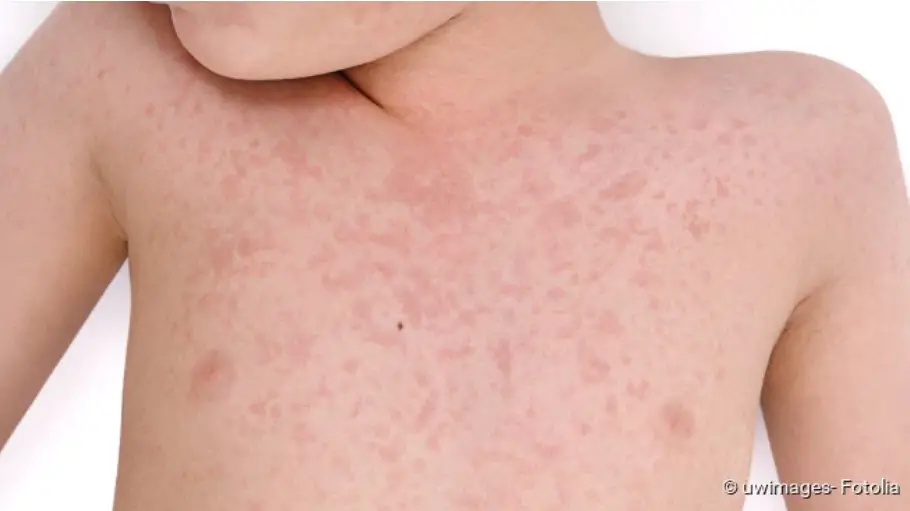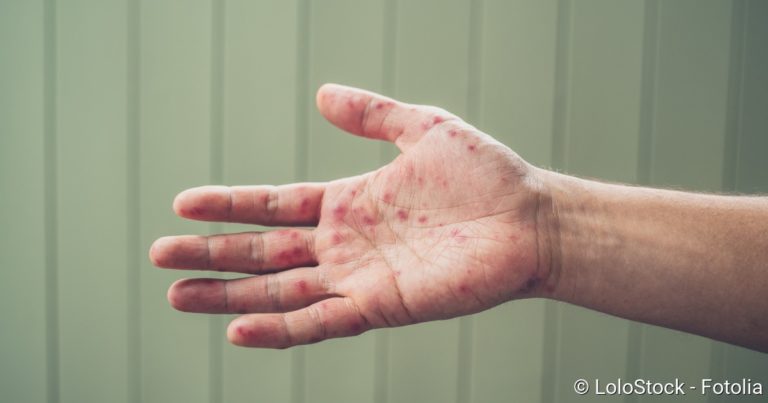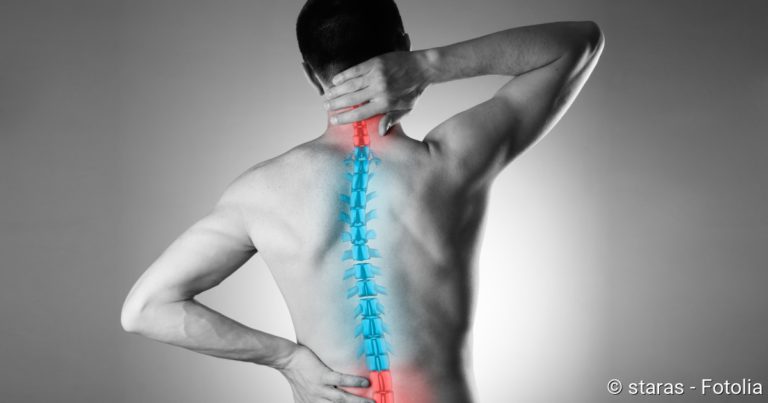Fifth Disease: Symptoms, infection, dangers, therapy
Fifth Disease: Symptoms, infection, dangers, therapy
Brief overview
- Cause: Parvovirus B19
- Symptoms: often none, otherwise: bright red skin rash, flu-like symptoms, in children possibly itching, in young women joint pain
- Infection: usually via droplet infection, less frequently via smear infection (shaking hands, infected objects)
- Diagnosis: typical skin rash, blood test, if necessary bone marrow sample
- Treatment: Ringed rubella often heals itself. Possibly the symptoms can be alleviated. No vaccination or medication against the virus is available.
- Prognosis: usually good; severe course possible in pregnant women and people with weakened immune system
Fifth Disease: Symptoms
An infection with the pathogen parvovirus B19 goes unnoticed in three quarters of all cases. Only a small proportion of those infected develop rubella symptoms. These can be different: Skin rash, flu-like symptoms (such as fever, headache and muscle pain) and anaemia can occur together or in isolation. The course of the ringlets can therefore be quite different.
Fifth Disease symptom: skin rash
The garland or ringlet-shaped skin rash is a characteristic symptom of rubella. However, it only occurs in about one in four patients. Presumably it is not directly triggered by the rubella virus, but is caused by the body’s own immune reaction against the pathogen.
The rash is not visible until one to two weeks after infection with the rubella virus. It often appears first on the face (especially on the cheeks and forehead) and then spreads to the arms, legs and bottom. With their symmetrical shape, the wavy spots, especially around the nose, may remind you of a butterfly. They can change their shape in the course of the disease. In some children the rubella rash is accompanied by itching.
After a few days the rash will disappear. But it can flare up again and again over a period of one to two months. This can be caused by a lot of sunlight or high temperatures (e.g. from a bath).
The fifth disease is one of the five teething troubles that can cause a rash, along with measles, rubella, chickenpox and scarlet fever. In English-speaking countries they are therefore also called “Fifth disease” whereas other countries called them in different ways, for example, Ringelröteln, or “eritema infeccioso”.
Fifth disease symptom: anaemia
Anemia in the fifth disease can occur because the virus particularly attacks the precursors of red blood cells (the erythroblasts). These are subsequently destroyed. Thus, the new formation of red blood cells comes out of the step – anemia develops. It manifests itself in the following symptoms:
- Tiredness and exhaustion
- Skin pallor: The blood is responsible for a healthy skin color; therefore, patients with anemia often appear pale.
- increased pulse: In order to ensure that the body cells still receive enough oxygen despite anaemia, the heart begins to pump the blood faster through the circulation.
Dangers from the fifth disease
In extreme cases, anemia caused by the fifth disease can develop into a so-called aplastic crisis. This leads to a complete cessation of blood formation, so that those affected are dependent on blood transfusions. People whose blood cells have only a short life span due to other diseases (e.g. thalassemia, sickle cell anaemia) or whose immune system is unable to fight the virus efficiently are particularly susceptible to an aplastic crisis.
A rubella infection in girls and young women and girls can lead to polyarthritis, i.e. inflammation of several joints. Knee, ankle and finger joints are particularly often affected. This inflammatory reaction is an erroneous reaction of the immune system, but it usually passes by itself and does not require any special treatment.
Fifth Disease: Infection
The virus usually spreads via a droplet infection: when sneezing, coughing and blowing, infected persons distribute small droplets of secretion in the room in which the infectious virus is located. Other people can inhale the droplets and thus infect them. The virus-containing saliva droplets can also be deposited on skin and objects. The pathogen is very stable and can survive for a long time. It can therefore also be transmitted if you shake hands with a sick person, touch a dirty door handle or toy (smear infection).
Fifth Disease: Incubation period
Fifth disease is not (if at all) noticeable immediately after infection: Between the infection and the appearance of the first symptoms, there is usually a period of less than two weeks. This period of time is called the incubation period.
Duration of contagiousness
However, those affected are already infectious a few days after infection and even before a rash appears (if it develops at all). As soon as the rash develops, there is virtually no risk of infection.
The phenomenon of being contagious even before symptoms appear is partly responsible for the fact that infections with fifth disease are particularly frequent in kindergartens and schools. Affected children do not stay at home because the infection is usually not detected. This is why epidemics can occur, especially in winter and spring.
After an infection, however, those affected are immune to the disease for the rest of their lives.
Fifth Disease in adults & teenagers
As a typical childhood disease, fifth disease rarely affects adults. According to blood tests, 60 to 70 percent of all thirty-year-olds are already immune to the infection – they had already had contact with the parvovirus B19 earlier (mostly in childhood) and have been immune to it ever since.
Those who are infected with fifth disease only as adults rarely get the rash typical of children. Most adult patients (especially young women) develop acute inflammation in several joints (polyarthritis). The symptoms are similar to those of rheumatoid arthritis. To differentiate, the doctor can determine the rheumatoid factor in the patient’s blood. If this is positive, there is probably arthritis. However, if the rheumatoid factor is negative and certain antibodies against the fifth disease virus are found in the blood, it is actually polyarthritis due to fifth disease.
Like other children’s diseases, the infection can cause unusually severe symptoms in adulthood and can be difficult to treat. It can be particularly dangerous for pregnant women (see below) and people with weakened immune systems.
Especially pregnant women as well as people in close contact with pregnant women should be aware of the danger of an infection and prevent an infection avoiding contact with infected persons.
Fifth disease in teenagers
The disease also manifests itself differently in young people than in children. An infection often leads to the so-called glove-sock syndrome. This is a rash that is strictly limited to the hands and feet – i.e. those areas of skin covered by socks and gloves. The skin lesions differ from the typical rash in that they are more likely to appear as small red spots or papules and an increased blood vessel pattern on the skin.
Fifth Disease: Pregnancy
Two thirds of women of childbearing age are immune to the ringworm pathogen. This is a good thing, because if a pregnant woman gets infected with rubella, this can have serious consequences for the unborn child.
It is true that the parovirus B19 does not cause any direct malformations or disabilities. However, it can get into the child’s bloodstream via the placenta, infecting the haematopoietic cells there and causing anaemia. This interferes with the supply of oxygen and nutrients to the child and consequently with its development.
If rubella is suspected, the pregnancy should therefore be closely monitored by ultrasound. Thus, at the first signs of a reduced blood volume in the child, suitable measures can be taken to counteract this.
Learn more about the risks and treatment of rubella in pregnancy in the article regarding Fifth Disease And Pregnancy
Fifth Disease: Causes and risk factors
The trigger of the ringworm is the parvovirus B19. It is the smallest known virus that can cause disease in humans (smallest human pathogenic virus).
Parvovirus B19 recognizes a very specific surface structure of erythroblasts (precursors of red blood cells) and penetrates these cells. Some people lack this characteristic structure on their blood cells. They are therefore immune to the parvovirus from birth.
The pathogens are widespread. This is because infected people can pass on the viruses to other people just a few days after infection and even before the (possible) outbreak of the rash. The virus is very stable and can survive outside the body on surfaces for a long time. This favours dissemination. However, the virus is not as infectious as measles, rubella or pox viruses, for example. In addition, it usually only causes a harmless infection, which in many cases goes unnoticed.
There is no vaccine against parvovirus B19. The only way to protect yourself from an infection is to avoid close contact with infected persons and to wash your hands regularly.
Fifth Disease: Examinations and diagnosis
The doctor usually diagnoses Ringel rubella on the basis of the typical skin rash. If symptoms are unclear or in patients without the rash, a blood test can confirm the diagnosis: In the blood of infected persons, either antibodies against the rubella virus or the virus itself can be detected.
Even years after an infection with the fifth disease, specific antibodies against the pathogen are still circulating in the blood of the affected person. For this reason, women who wish to have children can have a blood test carried out before pregnancy to determine whether they have already had contact with the pathogen and are therefore now immune to rubella.
Only in rare cases does the doctor have to take a bone marrow sample (bone marrow puncture). If the patient actually has the rubella, the parvovirus B19 can be detected in the sample.
Fifth Disease: Treatment
In most cases the condition heals by itself and does not need to be treated at all. Targeted treatment with an antiviral drug is not available for a parvovirus B19 infection. In more severe cases one can therefore only try to alleviate the symptoms of this affection:
Doctors often prescribe medication against fever and pain. Cold compresses can help against the itching that sometimes accompanies the rash. In case of severe anaemia, a blood transfusion may be necessary.
Patients with a disturbed immune system (immunodeficiency) sometimes receive special antibodies to support the body in its fight against the pathogen. However, this therapy is very expensive and only necessary in the case of chronic anaemia.
Fifth Disease: Course of disease and prognosis
The course of the ringlets can be very different. Many people do not notice the infection at all while others develop flu-like symptoms, possibly followed by the typical rash. Especially in young women, rubella often causes (only) joint pain.
The prognosis for rubella is generally good. Usually the body alone manages to fight the infection. However, pregnant women, people with weakened immune systems and those with anaemia are more prone to complications caused by rubella.






